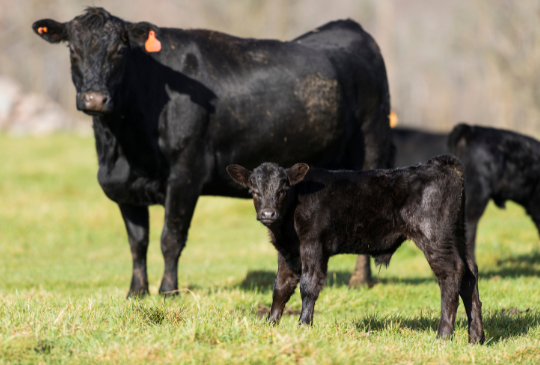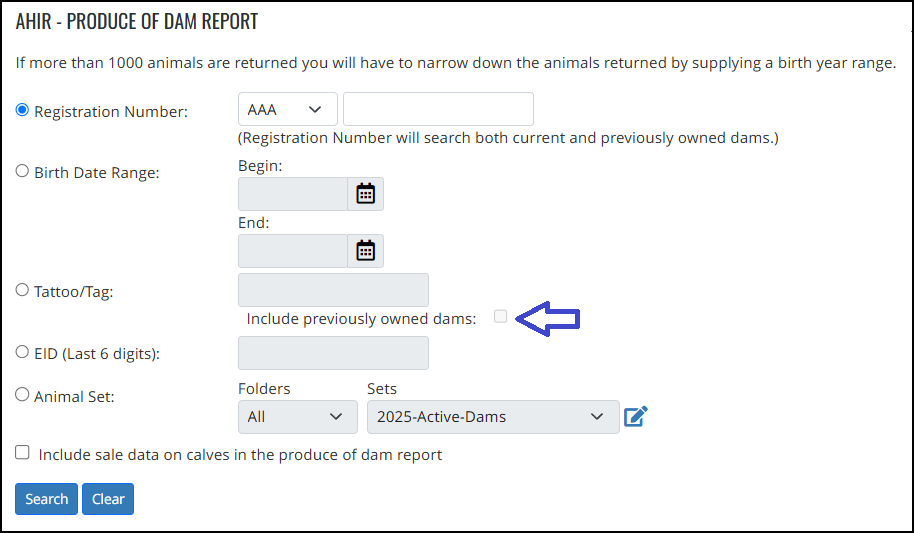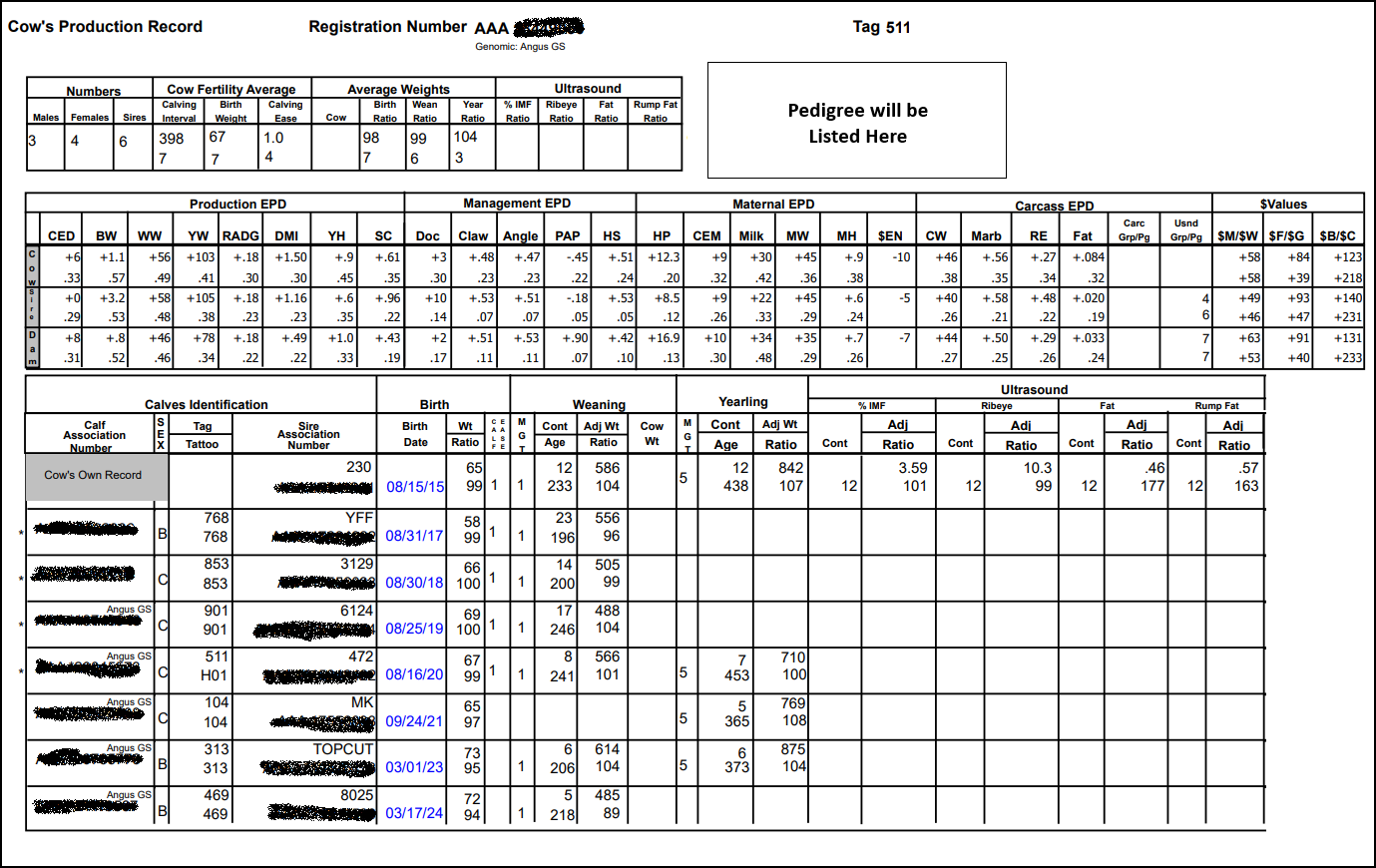Understanding the Produce of Dam Report: A Valuable Tool for Angus Producers
Understanding the Produce of Dam Report:
A Valuable Tool for Angus Producers


Criteria for Generating a Produce of Dam Report
Accessing and customizing the Produce of Dam Report within AAA Login is straightforward, offering a variety of search criteria to help breeders analyze their herd. To generate the report, navigate to: AAA Login > Reports > Dam Reports > Produce of Dam Report
From there, you can refine the data using multiple filters, including:
- Registration Number – Search for specific dams by their registration number.
- Birth Date Range – Narrow down results based on when the dam was born.
- Tattoo/Tag – Locate animals using their physical identification markers.
- Animal Sets – Compare production records across specific subsets of cows.
One particularly useful feature is the ability to include previously owned dams in the report. While you can enter a registration number, remembering all those numbers is unrealistic. Instead, selecting the "Include previously owned dams" checkbox within the Tattoo/Tag criteria allows for a broader and more convenient search.
Another valuable tool is the Animal Set feature, which enables breeders to compare performance records across different groups of females. For example, setting up two groups—one for younger cows (ages 3-6) and another for older cows (7+ years)—allows for a side-by-side evaluation of productivity across age groups. This can provide valuable insights into how different age classes contribute to herd efficiency and profitability.
Understanding the Results When Searching by a Single Tattoo

When searching for a single dam using her tattoo/tag in the Produce of Dam Report, the results provide a comprehensive snapshot of her production history and overall contribution to the herd. This information is crucial for evaluating her reproductive efficiency and the performance of her progeny.
Key Data Points in the Report
- Total Number of Calves – See how many calves the dam has produced throughout her lifetime.
- Calving Interval – Track the time between each of her calvings to assess her reproductive consistency.
- Birth Ratio – Quickly evaluate the birth ratios of her calves compared to the herd average.
- Weaning & Yearling Ratios – Get an at-a-glance look at how her progeny perform at weaning and yearling stages.
- Ultrasound Measurements – If any of her progeny have had ultrasound data recorded (such as ribeye area, back fat, or intramuscular fat), those results will also be displayed.
On the left side of the result grid, the dam’s tag appears as a clickable link. Clicking this link takes you to a detailed report for that specific dam, where you can review even more in-depth production and performance records.

Sorting by Age Groups and Key Performance Metrics
One of the most useful features of the Produce of Dam Report is the ability to filter and sort data to analyze specific age groups within your herd. By using the Animal Set feature, you can create custom groups—such as younger dams (3-6 years old) and older dams (7+ years old)—and select that set from the criteria screen before generating the report.
Once the results are displayed, the grid is fully sortable, allowing you to analyze progeny records in various ways:
- Sorting by Weaning Ratio – Click on the Wean Ratio column to instantly rank the progeny by their weaning performance. A small arrow will appear to indicate sorting order.
- Sorting by Birth Ratio – Click on Birth Ratio to quickly see which dams are producing calves with the most favorable birth weights compared to herd averages.
- Sorting by Any Other Column – Simply repeat the process for any available data point, such as Yearling Ratios or Ultrasound Scan Results.
- Reversing Sort Order – Click the same column header again to switch between ascending and descending order.
This dynamic sorting feature allows breeders to quickly identify trends, such as which dams are producing the most growth-efficient calves or which ones might need closer evaluation.

Diving into the Detailed Produce of Dam Report
The Produce of Dam Report is an essential tool for evaluating a cow’s lifetime productivity and the impact she has had on the herd. While the initial results screen provides a high-level overview, the detailed report offers even deeper insights, listing all progeny data along with genetic and performance metrics. Taking the time to fully understand this report can lead to better-informed breeding and culling decisions, ultimately benefiting the efficiency and profitability of your herd.
At the top of the detailed report, you’ll find a high-level overview:
- Summary Data – The same key metrics from the initial grid results, including the number of calves, calving interval, birth ratio, and other performance ratios.
- Pedigree Information – Displayed on the right-hand side, showing the dam’s lineage. If other dams within the pedigree are owned by the ranch, their names will be clickable, allowing you to drill into their Produce of Dam Reports as well.
- EPD Data – Expected Progeny Differences (EPDs) for the dam, along with her sire and dam, helping assess her genetic potential.
The lower section of the report provides a detailed progeny performance section:
- Birth Weights & Ratios – See how her calves compare to the herd average at birth.
- Adjusted Weaning & Yearling Weights – Including ratios that help assess each calf’s growth performance.
- Ultrasound Scan Data – If recorded, carcass traits such as % IMF, Ribeye, Fat, and Rump Fat will be displayed.
Special Features Within the Report
- Cow’s Own Record – The dam herself is listed at the top of the progeny section under the label "Cow’s Own Record", providing a reference point for her individual data.
- Drill-Down Capabilities – Clicking on the birth date of any progeny allows you to access their Performance Details Page, which includes Full EPD breakdown, Genomic Percent Ranks, and Individual performance records submitted for that animal
One of the most convenient features of the Produce of Dam Report is its print-friendly format. If you need to compare specific dams and analyze their production records on a progeny-by-progeny basis, printing these reports allows you to lay out the data side by side for deeper evaluation.
By printing multiple reports, you can:
- Compare individual dams to identify the most productive females in your herd.
- Evaluate progeny performance across different cows to assess which genetics are excelling.
- Make informed culling and breeding decisions based on historical production data.
Having hard copies of these reports can be particularly useful during herd evaluations, sales planning, or breeding meetings, where you may want to reference and discuss the data without relying on a digital screen.
Maximizing the Value of the Produce of Dam Report
The Produce of Dam Report is an essential tool for Angus breeders, providing a detailed overview of a cow’s reproductive history, progeny performance, and genetic impact on the herd. With customizable search criteria, including registration numbers, tattoos, birth date ranges, and animal sets, breeders can tailor the report to focus on specific dams or groups. The ability to include previously owned dams and compare performance across age groups makes this report even more powerful. Additionally, the detailed progeny section offers insights into birth weights, weaning and yearling ratios, ultrasound data, and EPDs—helping breeders make informed decisions about breeding, culling, and herd management.
The Association’s AHIR program enables breeders to create calving records for both commercial and registered cows. By recording performance data for commercial calves alongside registered ones, breeders can also generate Produce of Dam Reports for their commercial cows, allowing for comprehensive herd evaluation and performance tracking across all females.
Beyond data access, the report’s sortable grid and print-friendly format make it easy to analyze and compare multiple dams at once. Sorting by key performance indicators, such as weaning or birth ratios, allows breeders to quickly identify top-performing females and their most productive offspring. Whether viewed digitally or printed for hands-on evaluation, this report equips Angus breeders with the insights needed to refine their breeding programs, improve herd efficiency, and enhance overall profitability. By fully utilizing the Produce of Dam Report, breeders can ensure their herd is built on strong, productive, and genetically superior females.
